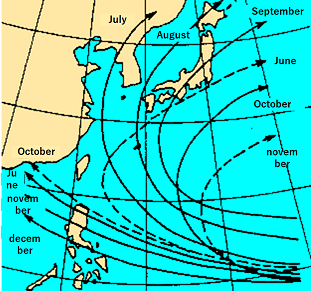Damage caused by typhoon
Typhoon damage is mainly divided into damage caused by strong winds and damage caused by heavy rain.
Damage caused by storm
The damage caused by typhoons varies depending on the average wind speed. When winds blow at speeds of 15 to 20 m/s, pedestrians may fall, and driving on expressways may become difficult. If it gets even stronger, it can cause damage to buildings and crops, and traffic disturbances. Additionally, if the maximum wind speed exceeds 40m/s, utility poles may fall. In addition, strong winds can also cause storm surges and high waves.
Damage caused by heavy rain
Heavy rains caused by typhoons cause large amounts of rain to fall over a wide area in a short period of time. As a result, river water rises are likely to occur, resulting in flood damage such as flooding and flooding. Rain also causes landslide disasters such as landslides and debris flows.
Wind strength and influence
There are various effects depending on the strength of the wind.
Impact on people
| 15~20m/s I can't walk against the wind. Some people fall. High places are extremely dangerous. |
20~25m/s I can't stand unless I'm holding on to something. There is a risk of injury from flying objects. |
25m/s~ Outdoors is extremely dangerous |
Impact on buildings, trees, etc.
| 15~20m/s Electric wires may start to curl, and signs and boards may come off. |
20~35m/s Thin trees begin to sag, and trees with no roots begin to fall. Signboards, etc. fall and are scattered. |
35m/s~ Many trees fall. Telephone poles, streetlights, block walls, etc. may fall. |
Typhoon path
Typhoons occur in low latitudes in early spring, tend to move westward, and are not very numerous. However, as summer approaches, the latitudes where they occur increase, the number of them increases, and the number of them approaching and landing on Japan increases significantly.
Occurrence, approach, and landfall of a typhoon
According to information from the Japan Meteorological Agency, the occurrence rate, approach rate, and landfall rate of typhoons are most frequent from July to October. They are particularly common in August and September, so you need to be careful during these times.
Typhoon path

©Source: Japan Meteorological Agency “Typhoon Path” |
Looking at this image, you can see that they often land in Japan Typhoons that occur in June and October often pass near Japan, so you need to be wary of typhoons that occur during these months. |
|---|


